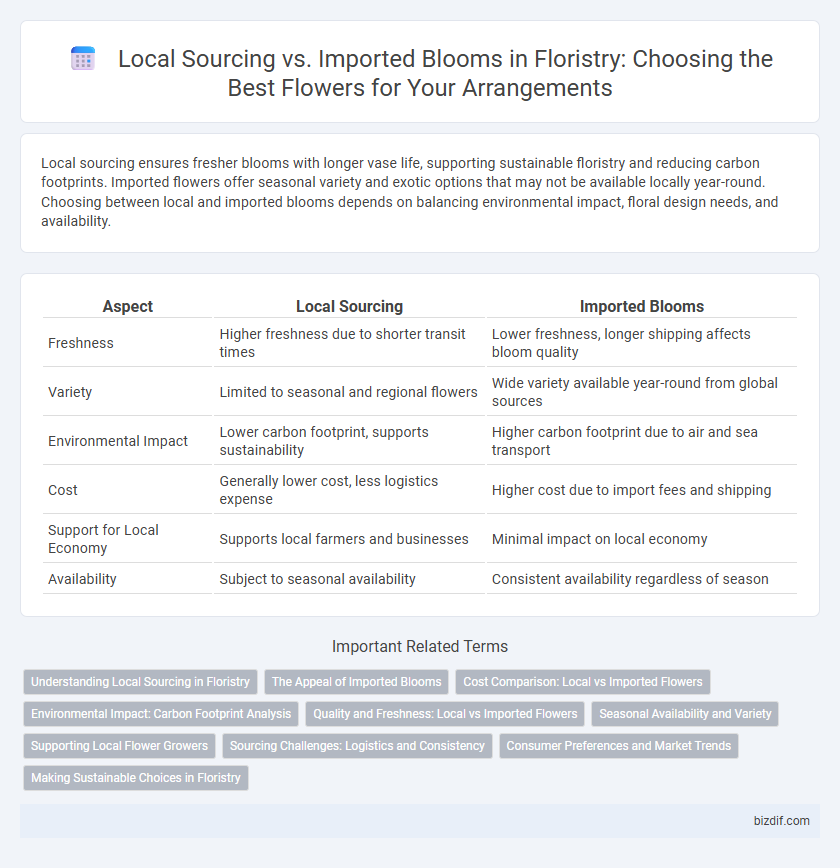Local sourcing ensures fresher blooms with longer vase life, supporting sustainable floristry and reducing carbon footprints. Imported flowers offer seasonal variety and exotic options that may not be available locally year-round. Choosing between local and imported blooms depends on balancing environmental impact, floral design needs, and availability.
Table of Comparison
| Aspect | Local Sourcing | Imported Blooms |
|---|---|---|
| Freshness | Higher freshness due to shorter transit times | Lower freshness, longer shipping affects bloom quality |
| Variety | Limited to seasonal and regional flowers | Wide variety available year-round from global sources |
| Environmental Impact | Lower carbon footprint, supports sustainability | Higher carbon footprint due to air and sea transport |
| Cost | Generally lower cost, less logistics expense | Higher cost due to import fees and shipping |
| Support for Local Economy | Supports local farmers and businesses | Minimal impact on local economy |
| Availability | Subject to seasonal availability | Consistent availability regardless of season |
Understanding Local Sourcing in Floristry
Local sourcing in floristry emphasizes using flowers grown within a particular region, promoting freshness and reducing carbon footprints. Seasonal blooms harvested nearby support local economies and ensure optimal durability and vibrancy for arrangements. This practice contrasts with imported blooms, which often undergo lengthy transit times, potentially affecting flower quality and environmental sustainability.
The Appeal of Imported Blooms
Imported blooms captivate with their exotic varieties and vibrant colors unavailable locally, enhancing floral arrangements with unique aesthetics. Access to imported flowers extends seasonal options, ensuring availability during off-peak periods and special events. Superior quality control and innovative cultivation techniques from global suppliers contribute to longer-lasting freshness and visual appeal.
Cost Comparison: Local vs Imported Flowers
Local flowers typically cost less due to reduced transportation and storage expenses, resulting in fresher blooms and lower environmental impact. Imported flowers often incur higher costs from international shipping, customs duties, and longer storage times, increasing the final price for consumers. Seasonal availability and regional growing conditions also influence price differences, with local sourcing supporting community growers and potentially offering better value.
Environmental Impact: Carbon Footprint Analysis
Local sourcing of blooms significantly reduces carbon emissions by minimizing transportation distances and the need for air freight, which is a major contributor to the floristry sector's carbon footprint. Imported flowers often require energy-intensive cold storage and long-haul shipping, increasing greenhouse gas emissions and environmental degradation. Prioritizing locally grown flowers supports sustainable practices by lowering fossil fuel consumption, reducing waste, and promoting regional biodiversity conservation within floristry supply chains.
Quality and Freshness: Local vs Imported Flowers
Local sourcing of flowers typically ensures superior freshness and higher quality due to reduced transit times and minimal handling, preserving bloom vitality and color intensity. Imported flowers often endure longer shipping durations and exposure to varying environmental conditions, which can compromise petal integrity and overall appearance. Florists prioritizing freshness and longevity tend to favor locally grown blooms to enhance customer satisfaction and maintain floral arrangement excellence.
Seasonal Availability and Variety
Local sourcing in floristry ensures access to fresh, seasonal blooms that support sustainability and reduce carbon footprints, while offering flowers that reflect regional growing cycles. Imported blooms expand the variety available year-round, providing exotic and off-season options that are otherwise unattainable locally. Balancing local and imported flowers allows florists to meet diverse client demands while optimizing freshness and selection.
Supporting Local Flower Growers
Supporting local flower growers enhances sustainability by reducing carbon emissions associated with long-distance transportation. Locally sourced blooms ensure fresher, longer-lasting arrangements that reflect seasonal trends unique to the region. Investing in local florists stimulates the economy and fosters community relationships within the floristry industry.
Sourcing Challenges: Logistics and Consistency
Local sourcing of blooms often ensures fresher flowers and supports sustainable practices but poses logistic challenges such as limited seasonal availability and shorter shelf life. Imported blooms offer a wider variety and year-round consistency, yet face complexities like extended transit times, customs delays, and potential quality degradation. Balancing logistics and consistency remains a key challenge in floristry supply chains, impacting cost, design options, and customer satisfaction.
Consumer Preferences and Market Trends
Consumers increasingly prioritize sustainably sourced, locally grown blooms due to environmental concerns and demand for fresher flowers, boosting local floristry markets. Imported flowers often offer a wider variety and seasonal availability, appealing to consumers seeking exotic or off-season options despite a higher carbon footprint. Market trends indicate a growing shift towards transparency and ethical sourcing, encouraging florists to balance local sourcing with selective imports to meet diverse consumer preferences.
Making Sustainable Choices in Floristry
Local sourcing in floristry reduces carbon emissions by minimizing transportation distances and supports regional economies, ensuring fresher and more seasonal blooms. Imported flowers often involve higher environmental costs, including extensive fuel use and chemical preservatives, which impact sustainability. Choosing locally grown, organic blooms aligns with eco-friendly practices and contributes to a more sustainable floral industry.
Local sourcing vs imported blooms Infographic

 bizdif.com
bizdif.com